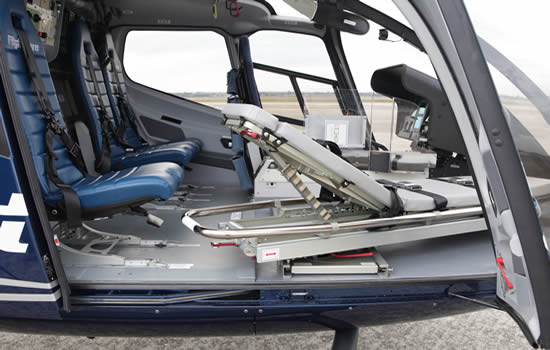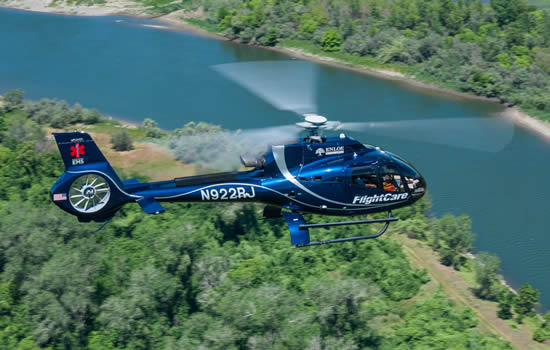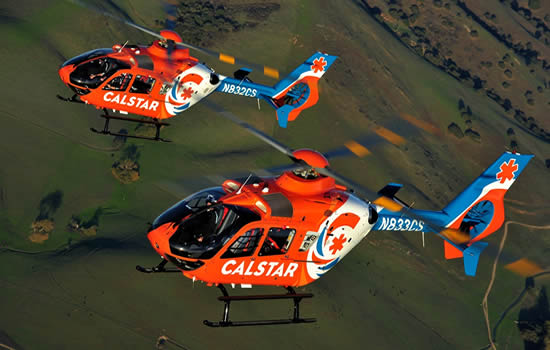|
Air medical transport operators are finding
the Airbus Helicopters H130 to be an economical, high-performance aircraft that
also allows them to provide higher quality care to critically ill and injured
patients.
With nearly 25 percent more cabin space than
other single engine helicopters, the H130 is giving operators the cabin space
and patient access of twin-engine helicopters with single-engine helicopter
economics.
“The H130 has really met our expectations,”
said Guy Barber,
MPH, Director of JeffSTAT, the medical transportation service affiliated with
the Thomas Jefferson University Hospital in Philadelphia. "We chose the H130 as
a complement to our existing Airbus Helicopters fleet which includes the H145
and H135. Our partnership with Air Methods Corp. has allowed us to leverage the
advantages and unique capability of each specific airframe type.
 |
|
H-130 Interior |
“The H-130 has proven to be a reliable and
capable platform well suited for the types of patients JeffSTAT is called upon
to care for. Our medical crews are especially appreciative of the medical
compartment and improved patient access it allows,” Barber said.
The JeffSTAT H130 will be on display at the
Airbus Helicopters Inc. Booth #401 during the Air Medical Transport Conference
held at the Charlotte Convention Center, in Charlotte, N.C. Dec. 13-15.
Introduced by Airbus Helicopters in 2012, the H130 has only recently become
available in the U.S. market for air medical operations because of high demand
from aerial tourism providers. The H130 was designed to meet the requirements of
a large, comfortable cabin for passengers and the demands of frequent flights.
“The air medical community’s ongoing challenge
is to improve care for patients with increasingly more critical and complex
illnesses and injuries, and to handle a growing population of bariatric
patients, all while being fiscally responsible. The H130 meets both the clinical
and fiscal challenges,” said Jennifer
Hardcastle, Air Medical Services Sales
Manager for Airbus Helicopters Inc.
The extra space and payload capability of the
H130 make it an attractive solution for providing high-quality critical care for
larger and more complex patients. The H130 has room for up to three medical crew
members and specialty equipment. Providers are often asked to fly family members
along with the patients, a task they can accomplish in the H130 because of its
cabin size, but typically cannot perform in other single-engine helicopters.
The wide, unobstructed H130 interior has a
significant amount of space between the stretcher and cabin. The fully
articulating litter system allows for true, full-body patient access as well as
the three-axis movement of the patient to maximize airway management and other
critical interventions, all while in flight. The large hinged and sliding doors
make for easy and rapid patient loading and unloading. Low interior sound levels
and a flat floor provide a flexible environment capable of accommodating crew
and equipment required for complex patients. An active vibration control system
and advanced air conditioning system combine to ensure that crew and patients
experience a smooth, comfortable transport.
Lehigh Valley Hospital, in Allentown, Pa. will
soon take delivery of a new H130. The choice of the H130 over competing models
came down to providing high-quality care at lower costs. “We did our due
diligence; people were all saying the same thing. They love the patient access,”
said Keith Micucci,
Director of Emergency Services. “Healthcare is changing. You have to get
smarter. You have to get better, and you’ve got to do it at a lower cost. We’re
excited to get the H130.”
Hospital Wing, a Memphis, Tenn.-based air
medical program, recently took delivery of its second H130 and plans to equip
its fleet with the model. “We’re transitioning to the H130 because of the large
cabin size and the service record,” said John Butora, CEO of Hospital Wing. “The
H130 is an excellent aircraft. It has fewer maintenance requirements and has an
added safety margin, which is important. This helicopter just works for us.”
 |
|
Enloe FlightCare's H-130 |
Enloe FlightCare in Chico, Calif. has been
operating an H130 for more than a year. “It’s amazing. Every single member of
our team loves it,” said Marty Marshall,
Director of Enloe Emergency Services and FlightCare, as well as a pilot.
Marshall said the Enloe program no longer has
to decline missions involving extremely large patients or those where family
members want to accompany the patient. “Within the first month with the H130 we
had flown parents with their children, which we couldn’t do before,” Marshall
said.
The H130 has performed well in the summer heat
and high altitudes of Central California, Marshall said, often operating at
density altitudes of 10,000 feet or more. “We’ve had absolutely no issues with
hot and high power. We’ve got plenty of power.”
The Turbomeca Arriel 2D turbine engine packs
952 SHP and offers better power margins and range than competing models, with
lower direct maintenance costs. Safety enhancements include a cabin design with
energy-attenuating seats, a crash-resistant fuel system, and a Vision 1000
flight data recorder.
H135 earns positive reviews from
California air medical provider
The powerful twin-engine Airbus Helicopters
H135 deftly navigated the heat and high altitude of California’s Sierra Nevada
Mountains after it was put into service last summer.
California Shock Trauma and Rescue (CALSTAR),
the first U.S. air medical transport service to operate the H135, reports the
aircraft has exceeded expectations. Based in Sacramento, Calif., CALSTAR took
delivery of two H135s in June and began operating the aircraft in air medical
missions in July.
“This is a powerful aircraft that responds
extremely well to our unique hot and high operating environment,” said
Lynn Malmstrom,
President, and CEO of CALSTAR. “It performed exactly as advertised, and we could
not be more pleased.”
CALSTAR selected the H135 in 2015 following a
fly-off with competing models that included tests in late summer heat and high
altitude conditions. CALSTAR flies many of its critical patient transports in
the Sierra Nevada and nearby foothills, responding to injured hikers, boaters,
and cyclists in the summer and skiers in the winter.
 |
|
CALSTAR helicopters in flight |
CALSTAR’s Chief Operations Officer
Tad Henderson
said flight crews are impressed with the H135’s strength and safety features,
including the Garmin GTN 750 fully integrated navigation, communication, and GPS
avionics system. This system allows enhanced operation under instrument flight
rules, improving safety margins at night or in hazardous weather and terrain.
“The technological advancements made in the
H135 in a short time are incredible. These aircraft practically fly themselves,”
Henderson said. “When you are operating in an environment as diverse as ours,
it’s reassuring to know you have a premier aircraft.”
The new H135s replaced CALSTAR’s remaining
four legacy B0105LS helicopters, completing a fleet modernization plan launched
in 2012. CALSTAR also operates eight EC135s, the model’s previous version, that
it ordered in 2012.
The H135 is the industry reference for light
twin-engine helicopters due to its performance, safety features, operating
efficiency and cabin flexibility. Equipped with Pratt & Whitney PW206B3 turbine
engines and a new, larger main rotor, the H135 provides 440 pounds of greater
payload capacity in hot-and-high conditions. It also has improved performance
and payload at lower altitudes.
CALSTAR’s longstanding relationship with
Airbus Helicopters Inc. made the decision to acquire the H135 simple, Malmstrom
said. “Taking a risk on a new platform might be perceived as a risk to some, but
our long and trusted relationship with Airbus Helicopters made it easy to
acquire another Airbus product,” he said. “We continue to be incredibly happy
with the H135.”
|

